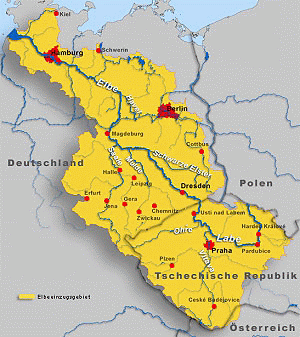
The Elbe is one of Europe’s major rivers.The total length of the river from its source in the Krkonoše (or sometimes called „Giant“) Mountains to the North Sea is 1094 km. The Elbe River Basin covers an area of 148,268 km² making it the fourth largest river basin in Central Europe after the Danube, Vistula and Rhine basins. 65.5% of the total river basin are located in Germany and 33.7% in Czech Republic, whereas Poland and Austria hold 0.2% and 0.6% respectively. The Elbe River Basin is a populous cultural landscape, counting approximately 25 million residents. The largest and best-known cities in the river basin are Berlin, Hamburg and Prague.
Rivers and lakes in the German Elbe River Basin
With a river basin of approximately 24,000 km² each, the rivers Saale and Havel are the Elbe's main tributaries, followed by the rivers Mulde and Schwarze Elster with over 5000 km² each. The rivers Spree, Unstrut and Weiße Elster also make up for an important share of the Elbe River Basin.
The Müritz, the Schweriner See, the Plauer See and the Kölpinsee in Mecklenburg-Western Pomerania are all significant lakes in the Elbe River Basin. The largest dam lakes were created by the dams in Bleiloch and Hohenwarte (Thuringia) as well as in Bautzen and Eibenstock (Saxony). The Goitzschesee in Saxony-Anhalt is the largest artificial lake and was created by filling an opencast mine.
The Elbe River Basin furthermore includes the North Sea's transitional and coastal waters and the island of Helgoland.